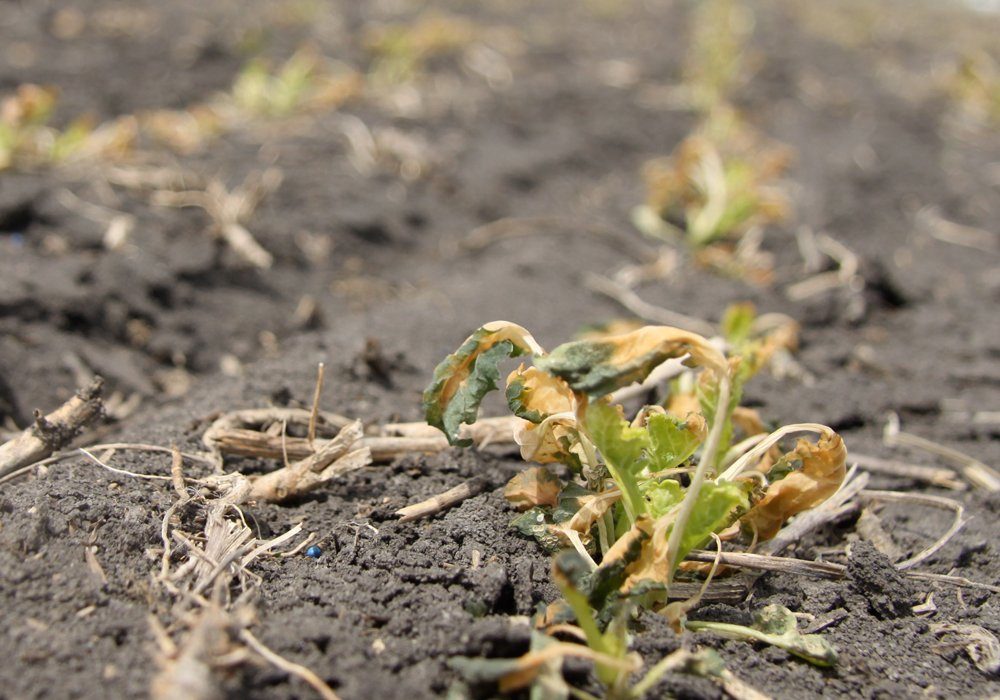Frost threatens Manitoba crops tonight

A frost is expected tonight in Manitoba and a portion of the province’s canola and soybean crop may suffer a killing freeze.
Temperatures are forecast to sink to –3 C in much of southern Manitoba on Wednesday night and Thursday morning. If the forecast is correct and air temperatures do sink to that level for several hours, some growers may need to reseed canola and soybeans. Those two crops are particularly sensitive to freezing temperatures.
“It is worrisome right now for soybeans because we’re seeing them emerge last week,” said Cassandra Tkachuk, production specialist with the Manitoba Pulse and Soybean Growers.
“Minus two or colder is considered a hard or killing frost…. If those temperatures persist for more than two hours, you can have some pretty severe damage to your plants that are out of the ground.”
As of May 25, Tkachuk estimated that 30 to 40 percent of the soybeans in Manitoba have emerged. Assuming 1.1 to 1.3 million soybean acres in Manitoba this year, several hundred thousand acres could be at risk.
A portion of the province’s canola crop could also suffer frost damage. However, it’s hard to predict what will happen because frost is “patchy”, said Dane Froese, oilseed specialist with Manitoba Agriculture.
Some Manitoba canola and soybean crops are expected to freeze on Wednesday night, but a repeat of May 2015 is unlikely. On May 30 that year, temperatures sank to -4 to -7 for four or five hours. The severe frost smoked seedlings in much of southern Manitoba and farmers had to reseed nearly a million acres of canola.
That probably won’t happen this year because less canola has emerged from the soil. Many farmers in Western Manitoba halted seeding in the middle of May because the topsoil was extremely dry.
“We’re seeding into dust and we stopped seeding yesterday,” said Melissa Atchison, who operates a cattle ranch and grows some annual crops near Pipestone, Man., on May 15.
Rain finally arrived over the May long weekend, but the delay in canola seeding should lessen frost damage because part of the province’s canola crop hasn’t been seeded or hasn’t emerged.
“We don’t expect it (frost damage) to be extremely large, but it could be detrimental to some of those very early canola crops,” Froese said.
It’s possible that wet soils, thanks to 50-75 millimetres of rain over the long weekend, will protect canola and soybean seedlings from the frost. Wet soils store more heat.
“Dry soils are subject to broader swings in temperatures than wet soils,” Froese said.
Young plants can also ‘harden’ when subjected to cool temperatures prior to a frost.
Temperatures in Manitoba were cool during part of the long weekend and near zero on the night of May 25. The chilly weather could toughen up canola and soybean plants so they can withstand a few hours of minus temperatures.
Nonetheless, if temperatures drop to -3 or colder, there will be regions and geographic pockets where reseeding is necessary. Growers should carefully check their crops before making a re-seeding decision.
“We want to wait and see if there is any regrowth happening,” Froese said. “The damaged tissue and damaged leaves may look visually very disturbing. That doesn’t mean that crop is toast.”
In the case of canola, farmers should wait 24 to 72 hours before assessing frost damage.
Ideally, they should look at plants in 20 or more locations within a field to gauge potential recovery.
Froese suggests checking for “new growth, within that one, two or five days … from that main growing point on the top of the canola cotyledon, or the top of the stem.”
For soybeans, growers should check the crop three to five days after the frost because it takes a few days for necrosis (tissue death) to set in.
“If that growing point isn’t killed off … you’ll see green material and maybe signs of regrowth,” Tkachuk said.
“You’ve got the two cotyledons on either side and the growing point is in the middle. So where you’ll see the regrowth is (at) the base of each cotyledon. That’s where you can end up with a double stem soybean plant … and it can still produce.”
If there are enough plants with new growth or regrowth, reseeding may not make economic sense. The reseeded crop will have lower yield potential because of a later seeding date. It also involves fuel, time and labour costs.
To help canola growers make a thoughtful decision about reseeding, Manitoba Agriculture has developed a calculator (Excel file). A link can be found in the province’s May 25 crop report at https://www.gov.mb.ca/agriculture/crops/seasonal-reports/crop-report-archive/pubs/crop-report-2021-05-25.pdf
Contact robert.arnason@producer.com
Source: producer.com

